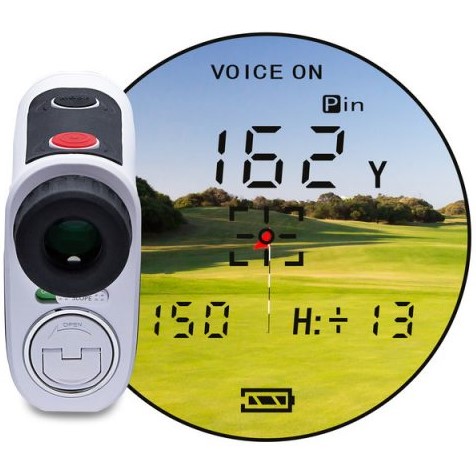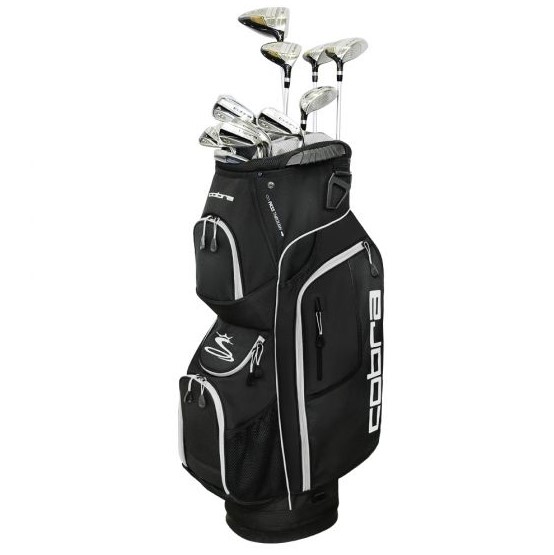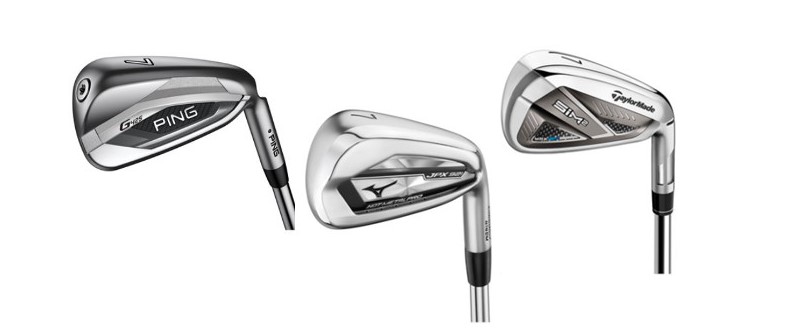Introduction
New golfers often find themselves overwhelmed by the extensive terminology and lingo associated with the sport. The world of golf irons, in particular, can be quite daunting and confusing. However, understanding the intricacies of golf irons is crucial for any golfer who wants to improve their game. In this comprehensive article, we will delve deep into the realm of golf irons, covering everything you need to know about their uses, variations, and tips for optimal performance.
Uses of Golf Irons
Golf irons serve a crucial role in a golfer’s arsenal, particularly when it comes to approach shots towards the green. While a golf driver helps launch the ball off the tee, irons come into action when it comes to landing shots on the green. Once you find yourself on the green (or just off it), wedges and putters take over, aiding you in directing the ball towards the hole.

Numbers on Golf Irons
It is essential to understand that the numbers marked on golf irons are not randomly assigned but indicate specific characteristics. The numbers directly relate to the amount of loft a golf iron possesses and the typical distance the ball is expected to cover. Lower-numbered irons have less loft, resulting in a lower ball flight but greater distance. On the other hand, higher-numbered irons possess more loft, allowing for a higher ball flight but shorter distance.
To illustrate this, let’s consider the graphic above, indicating the range of lofts, starting from a 4-iron (left) and going up to a pitching wedge (right).
Unique Distances of Golf Irons
Each iron in a golf set is painstakingly designed to fly a specific distance, ensuring versatility for players in various situations. As golfers progress in skill level, they start to notice a distance variation of around ten yards between each iron in their set. This variation in lofts and distances allows players to fine-tune their shots, enhancing precision and overall control.
Types of Irons
Golf irons can be broadly categorized into long irons, mid irons, and short irons, each serving a distinct purpose and offering different characteristics.
1. Long Irons
Long irons typically include the 2, 3, and 4-irons in a golfer’s set. These clubs are distinguished by their slightly longer length and lower loft. Consequently, when using long irons, golfers can expect shots with a more penetrating ball flight, allowing the ball to travel great distances across the course.
2. Mid Irons
Mid irons comprise the 5, 6, and 7-irons, and they are among the most commonly used clubs for golfers. These clubs strike a balance between loft and distance, providing a medium ball flight and an average distance that suits a variety of scenarios on the golf course.
3. Short Irons
Short irons consist of the 8, 9, and pitching wedge. While some golfers may classify the pitching wedge as part of the wedge category, for most players, it aligns with the other clubs in the iron set. Short irons are crucial when precision and accuracy are paramount. They excel in generating short approach shots towards the green, offering control over trajectory and spin.
Approach Wedge (AW), Pitching Wedge (PW), Sand Wedge (SW), and Lob Wedge (LW)
In addition to the traditional iron set, golfers often include specialized wedges in their bag to handle specific situations. Let’s explore the distinctive properties of these wedges:
1. Approach Wedge (AW)
The “A” on a golf club stands for approach, which is typically found on a club known as an approach wedge or gap wedge (AW). This club fills the loft gap between a pitching wedge and a sand wedge, usually with loft around 52º. An AW offers golfers greater versatility and control in approach shots.
2. Pitching Wedge (PW)
Labeled as PW, the pitching wedge is revered among players due to its user-friendly nature and versatility. It is one of the most favored clubs in a player’s bag. The pitching wedge offers an ideal balance of loft and distance, making it an invaluable tool for various shots on the course.
3. Sand Wedge (SW)
The S on a golf club stands for a sand wedge, often labeled SW. Golfers utilize this club to execute shots from bunkers and to deliver precise chips and pitches onto the green. The unique design and loft of the sand wedge make it adept at handling challenging shots around the greenside.
4. Lob Wedge (LW)
The L on a golf club represents a lob wedge, sometimes labeled as LW. The lob wedge boasts the highest loft among the wedges, typically around 60 degrees. This club is a golfer’s go-to tool for tackling greenside bunkers and executing shorter approach shots with a higher trajectory.
Golf Iron Features and Yardage
Golf irons exhibit distinctive characteristics in terms of loft, clubhead design, and other factors, all of which directly influence the yardage they offer on a shot. It is essential to emphasize that achieving optimal distance and accuracy is contingent upon striking the ball near the center of the clubface.

Determining Yardages and Distance Control
A crucial step in perfecting your iron game is determining the yardages you can achieve with each club. As you consistently strike shots well, it becomes imperative to identify the precise yardage for each iron in your set. This knowledge becomes crucial when you step onto the golf course, allowing you to make informed decisions regarding course management and distance control.
Choosing Clubs on the Golf Course
When deciding which club to use in various situations on the golf course, several factors come into play. While it may be tempting to use a 7-iron because you can hit it 150 yards with a perfect strike, many skilled golfers opt to hit iron shots at around 85% power. This strategy provides them with better control over the ball during their swings. Applying this tactic allows them to take an extra club and swing with ease, which proves beneficial for many golfers.
Furthermore, while the driver is typically the go-to club for teeing off due to its potential for long-distance shots, there are instances when other clubs can offer better control. For example, if a golfer is struggling to control their driver on a particular day, they may opt for a 3 wood or even a 5-iron to ensure they can keep the ball in play, especially if the fairway narrows further down the hole.
Selection of a club for par 3 holes is primarily based on the yardage of the hole. Longer holes may require lower lofted irons or even woods, while shorter holes with downhill or downwind play may demand less club selection.
Chipping with Irons and Wedges
When it comes to chipping, the choice of club depends on the lie and distance to the hole. Most golfers find that using a sand wedge or pitching wedge yields the best results for chipping. It is crucial to develop proficiency in executing different types of shots around the green so that you are adequately equipped to handle any situation you may encounter during a round of golf. Through practice, you will discover which iron or wedge you feel most comfortable with on the actual golf course.
Recommended Clubs for Beginners
If you are new to golf, it can be overwhelming to select the right clubs to start with. But fear not, here are some recommendations:
1. 7-Iron
Considered one of the best clubs for beginners, the 7-iron is a mid-iron with fair loft, facilitating easy launch and playability from various lies. Its length offers comfort during practice, allowing beginners to build a solid foundation before venturing into longer and shorter irons.
2. 9-Iron
Regarded as the easiest iron to hit, the 9-iron boasts a considerable amount of loft, allowing golfers to get the ball up in the air effortlessly. This is particularly advantageous for beginners who may struggle with launching the ball. Incorporating a 9-iron in their set will significantly enhance their golfing experience.
Golf Club Set Makeup
The composition of a golfer’s clubs can vary, but the most common setup for the average player consists of five iron through pitching wedge. Additionally, many players include a gap wedge or AW to bridge the yardage gap between the pitching wedge and sand wedge. The Cobra XL set pictured above represents this typical iron set makeup.
Though some players may include a 3-iron in their set, it is important to note that, for 90% of golfers, this club is unnecessary. Better golfers with high swing speeds who can achieve a descending blow and consistently strike the center of the clubface may appreciate what a 3-iron offers. However, those with slower swing speeds or inconsistent strikes may struggle to launch the ball with sufficient height and should consider employing a more forgiving hybrid instead.
Tips for Hitting Hybrids off the Tee
While hybrids are commonly associated with long approach shots, they can also be effectively used off the tee. When teeing up a hybrid, it is advisable to position the ball close to the ground, similar to how you would tee an iron. This technique ensures that you make contact with the sweet spot on the center of the clubface. Many golf holes, especially par-threes or ones with doglegs or trouble, may lend themselves favorably to hitting a hybrid off the tee, providing golfers with greater control and accuracy.
Lifespan of Golf Irons
With consistent use, golf irons will eventually show signs of wear and tear. However, it is crucial to understand that these durable clubs take a long time to wear out. The grooves on the clubface may deteriorate over time, and there could be internal issues with cavity back or hollow construction irons. Nevertheless, before reaching the point of complete deterioration, advancements in technology often make older iron models outdated, potentially prompting golfers to upgrade their equipment and take advantage of the latest innovations.
It is worth noting that softer material irons, such as forged irons, may wear down quicker compared to cast golf clubs. However, all golf clubs generally endure tens of thousands of shots before experiencing significant wear and tear.
Most Forgiving Irons on the Market
The TaylorMade SIM Max OS irons reign as the most forgiving iron set available in the market today. These clubs boast a large sweet spot, ample loft, and impressive feel. Additionally, the clubhead itself incorporates a slight draw bias, greatly assisting golfers who consistently slice the ball. If you are seeking a blend of speed and forgiveness, the SIM Max OS presents the best overall option.
Conclusion
Mastering the complexities of golf irons is a crucial aspect of improving your golf game. By understanding their uses, variations, and yardages, players can make informed decisions on the course and execute shots more effectively. Whether you are a beginner or an experienced golfer, this detailed guide has provided valuable insights into golf irons. Should you have any further questions or require additional information, please feel free to leave a comment below, and we will be delighted to assist you.

